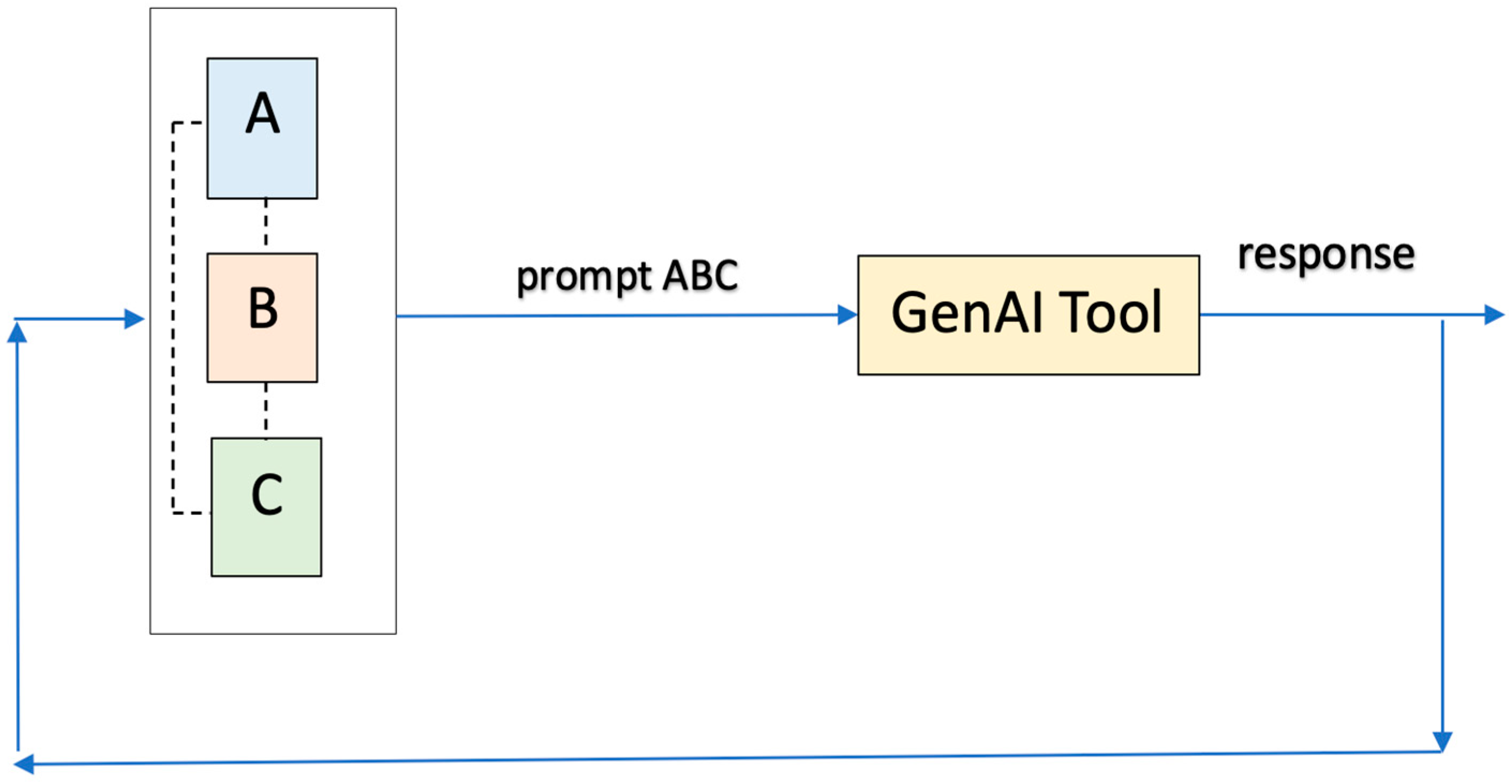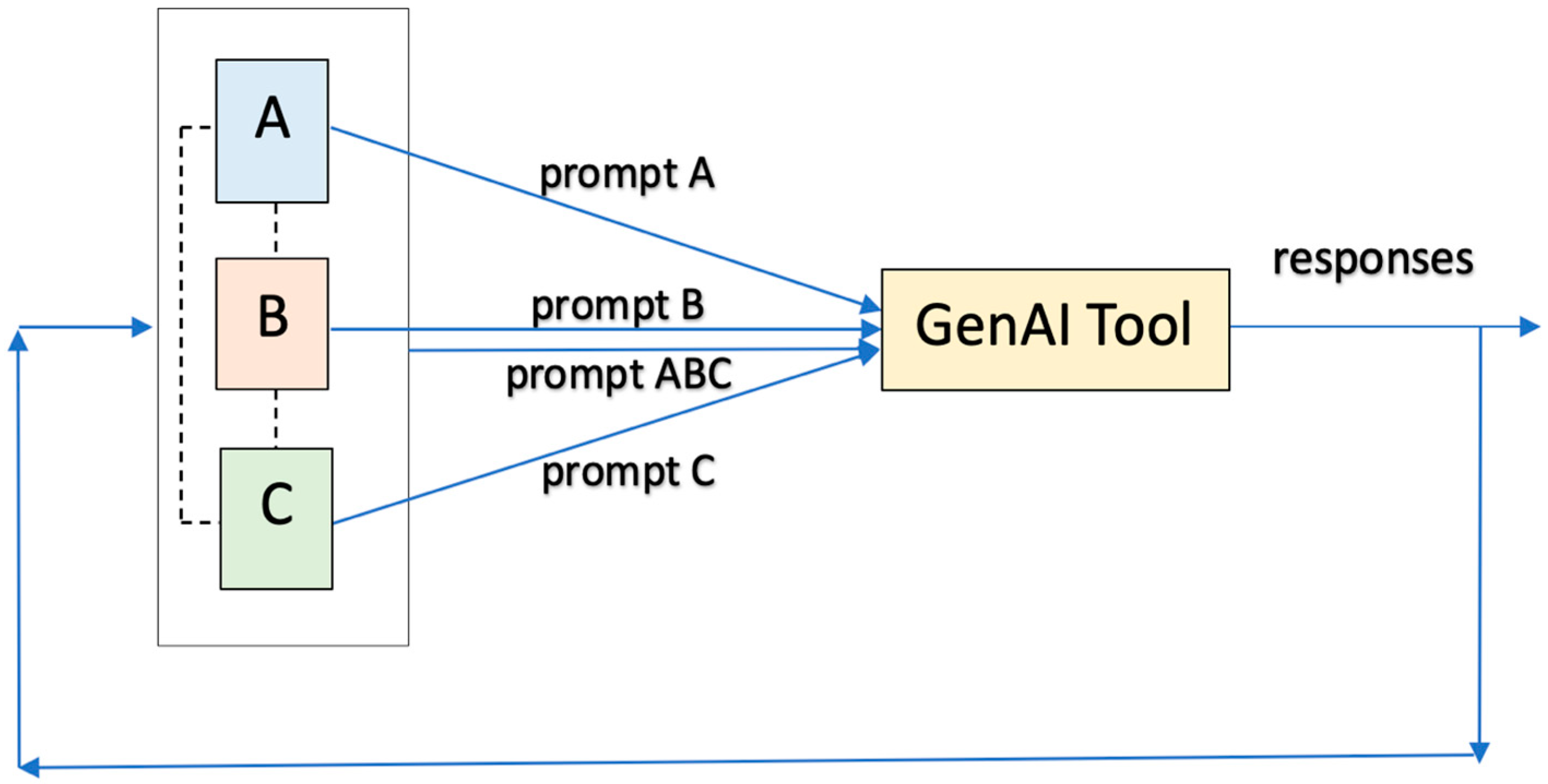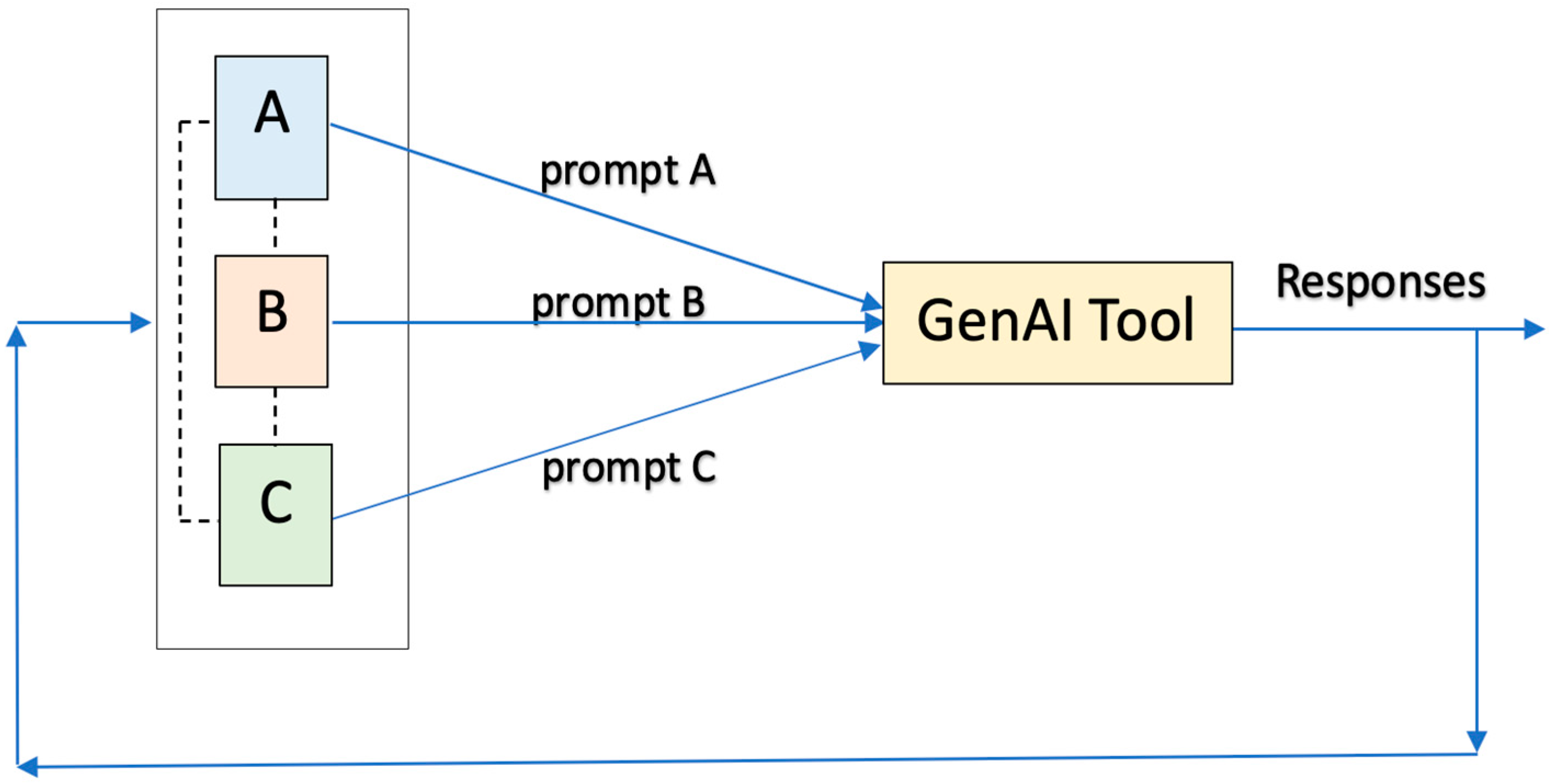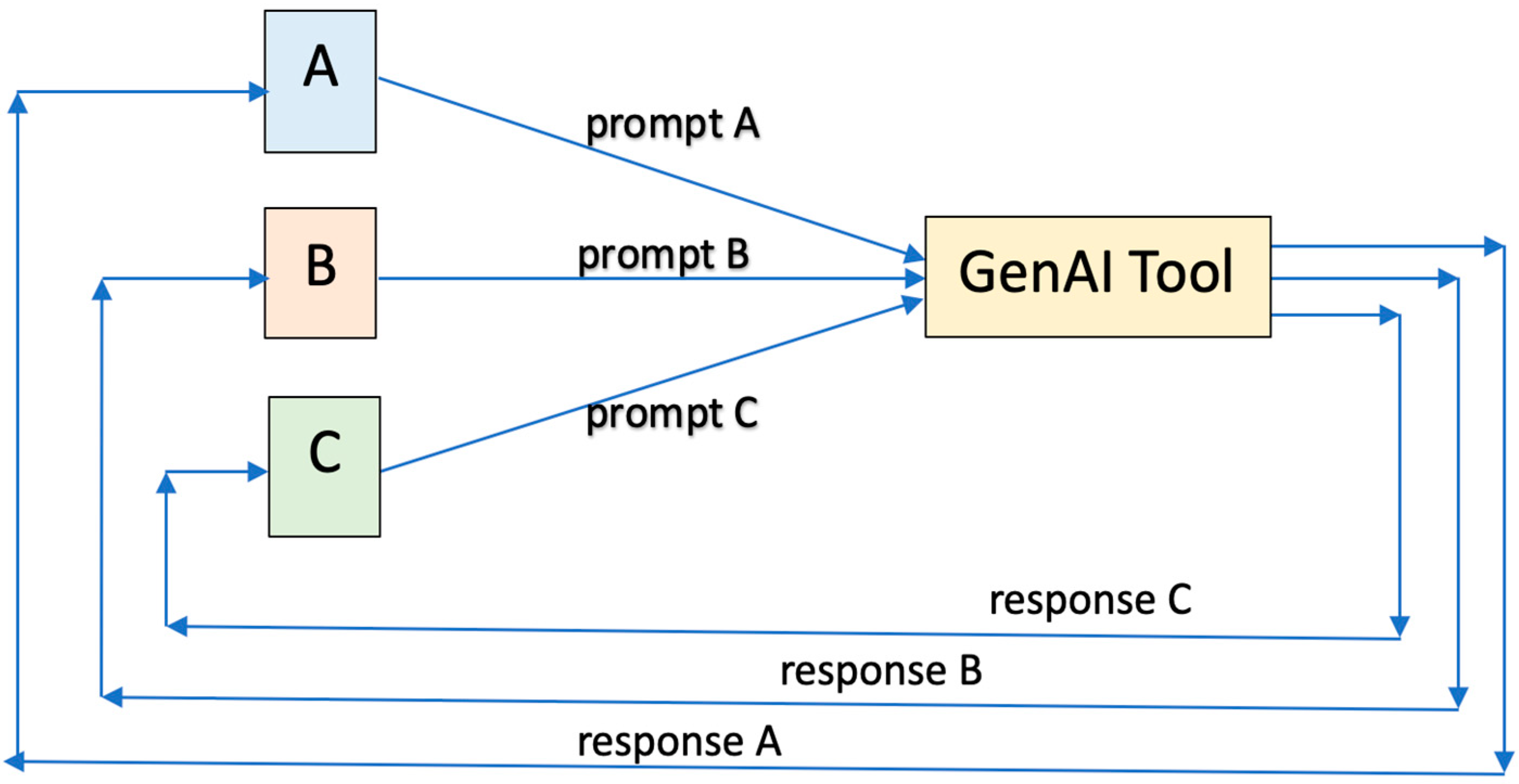Collaborative Uses of GenAI Tools in Project-Based Learning
Abstract
:1. Introduction
2. Previous Studies
3. Methodology
3.1. Research Design
3.2. Context and Participants
3.3. Data Collection Methods
4. Collaborative Project-Based Learning
4.1. Methodology for Collaborative Project Development Using GenAI
4.2. Collaborative Prompting When Using GenAI Tools
- (1)
- Collaborative Mode #1 (one in a row): A team member independently gives his/her own initial prompt to the GenAI tool (Figure 2). Based on the response (received by all members) of the GenAI tool, the second member revises the initial prompt and gives his/her own new prompt to the GenAI tool. Then, based on the new response (received by all) of the GenAI tool, the third member gives his/her own new prompt to the GenAI tool. Finally, all team members discuss the response (received by all) of the GenAI tool and arrive at the final result.
- (2)
- Collaborative Mode #2 (team-oriented): All team members discuss and agree to give a joint initial prompt to the GenAI tool (Figure 3). The team leader gives the joint prompt to the AI tool. Based on its response (received by all), they discuss again and agree to give a joint revised prompt to the GenAI tool. The team leader gives the joint revised prompt to the GenAI tool. And in the third iteration, members discuss the response (received by all) of the GenAI tool and agree on a joint new revised prompt. The leader gives the joint new revised prompt to the GenAI tool. Finally, all team members discuss the response (received by all) of the GenAI tool and arrive at the final result. This is the most straightforward mode of collaboration. Team members continually work together.
- (3)
- Collaborative Mode #3 (member then team): Each team member independently gives his/her own prompt to the GenAI tool (Figure 4). All team members discuss all GenAI tool responses (received by all) and agree on a joint revised prompt. The team leader gives the joint revised prompt to the GenAI tool. And in the third iteration, team members discuss the response (received by all) of the GenAI tool and agree on a joint new revised prompt. The leader gives the joint new revised prompt to the GenAI tool. Finally, all team members discuss the response (received by all) of the GenAI tool and arrive at the final result. In this mode, initially, each team member independently gives a prompt in order to explore different views. Then, the team members collaborate to design joint revised prompts. Finally, all team members decide on the final result.
- (4)
- Collaborative Mode #4 (team to member): Each team member independently gives his/her initial prompt to the GenAI tool (Figure 5). All team members discuss each result (received by all) of the GenAI tool and propose a revised prompt to each member. Each member independently decides on their own revised prompt and gives it to the GenAI tool. And in the third iteration, all team members discuss each response (received by all) of the GenAI tool and suggest to each member a revised prompt. Each member independently decides on their own revised prompt and gives it to the GenAI tool. Finally, all team members discuss the responses (received by all) of the GenAI tool and arrive at the final result. In this mode, each team member independently gives a prompt, taking into consideration the advice of their colleagues. Finally, all team members decide on the final result.
- (5)
- Collaborative Mode #5 (independently, cooperatively): The work is divided into three parts. Each team member works independently from the other members on a different part of the work. Each team member interacts alone with the GenAI tool to complete their part (Figure 6). Finally, all team members discuss the responses of the GenAI tool and agree on the final result. This is the simplest mode of collaboration or cooperation, where team members collaborate only to combine their parts.
5. Data Analysis and Results
5.1. Quantitative Results
5.1.1. Demographics and General Characteristics
5.1.2. Students’ Preferences Regarding Collaborative Modes
5.2. Qualitative Results
5.2.1. Prompting
5.2.2. Collaboration Among Team Members While Working with GenAI Tools
5.2.3. Communication Among Team Members
5.2.4. Advantages/Capabilities/Strengths of GenAI Tools
5.2.5. Weaknesses/Limitations/Shortcomings of GenAI Tools
5.2.6. Opportunities and Suggestions for Using GenAI Tools for Learning and Work
5.2.7. Obstacles and Risk Mitigation When Using GenAI Tools for Learning and Work
6. Discussion and Implications
7. Conclusions, Limitations, and Future Research
- Identifying preferred collaborative modes: The study pinpoints which collaborative modes (e.g., specific strategies for team interaction with GenAI) are favored by students.
- Highlighting key criteria for collaborative mode selection: It presents the factors that students consider important when choosing a collaborative mode, such as speed, effectiveness, knowledge exchange, and individual autonomy.
- Providing the Collaborative Preparation, Implementation, Revision (CoPIR) methodology for students to collaboratively develop their projects with GenAI help.
- Revealing challenges and suggestions: The study documents the problems students encounter while collaborating with GenAI and their ideas for improvement, including the need for a shared discussion space and structured history tracking for team discussions, within GenAI tools.
- Assessing learning perceptions: It examines students’ perceptions of their own learning and their team members’ learning in relation to their project grades.
- Documenting tool usage: The study records the digital tools and platforms students use for communication and collaboration, along with their satisfaction levels.
- Identifying advantages and disadvantages: It summarizes the strengths (e.g., speed) and weaknesses (e.g., inaccuracies, outdatedness) of GenAI tools, as perceived by students.
- Exploring opportunities and obstacles: The research explores the possibilities (e.g., personalized learning, time saving) and potential barriers (passive learning, privacy) to using GenAI tools effectively in learning and work environments.
Author Contributions
Funding
Institutional Review Board Statement
Informed Consent Statement
Data Availability Statement
Conflicts of Interest
Appendix A
- (1)
- Collaboration Among Team Members while Working with GenAI Tools:
- (2)
- Communication Among Team Members:
- (3)
- Advantages/Capabilities/Strengths of GenAI Tools:
- (4)
- Weaknesses/Limitations/Shortcomings of GenAI Tools:
- (5)
- Opportunities and Suggestions for Using GenAI Tools for Learning and Work:
- (6)
- Obstacles and Risk Mitigation when Using GenAI Tools for Learning and Work:
References
- Alnaim, N. (2024). Generative AI: A case study of ChatGPT’s impact on university students’ learning practices. preprint. [Google Scholar] [CrossRef]
- Barrett, N. E., Hsu, W. C., Liu, G. Z., Wang, H. C., & Yin, C. (2021). Computer-supported collaboration and written communication: Tools, methods, and approaches for second language learners in higher education. Human Behavior and Emerging Technologies, 3(2), 261–270. [Google Scholar] [CrossRef]
- Bell, S. (2010). Project-based learning for the 21st century: Skills for the future. The Clearing House, 83(2), 39–43. [Google Scholar] [CrossRef]
- Braun, V., & Clarke, V. (2006). Using thematic analysis in psychology. Qualitative Research in Psychology, 3(2), 77–101. [Google Scholar] [CrossRef]
- Braun, V., & Clarke, V. (2023). Thematic Analysis. In F. Maggino (Ed.), Encyclopedia of quality of life and well-being research. Springer. [Google Scholar] [CrossRef]
- Carter, N., Bryant-Lukosius, D., DiCenso, A., Blythe, J., & Neville, A. J. (2014). The use of triangulation in qualitative research. Oncology Nursing Forum, 41(5), 545–547. [Google Scholar] [CrossRef]
- Cotton, D. R. E., Cotton, P. A., & Shipway, J. R. (2024). Chatting and cheating: Ensuring academic integrity in the era of ChatGPT. Innovations in Education and Teaching International, 61(2), 228–239. [Google Scholar] [CrossRef]
- Crompton, H., & Burke, D. (2024). The educational affordances and challenges of ChatGPT: State of the field. TechTrends, 68, 380–392. [Google Scholar] [CrossRef]
- Das, S. R., & Madhusudan, J. V. (2024). Perceptions of higher education students towards ChatGPT usage. International Journal of Technology in Education (IJTE), 7(1), 86–106. [Google Scholar] [CrossRef]
- Deng, R., Jiang, M., Yu, X., Lu, Y., & Liu, S. (2025). Does ChatGPT enhance student learning? A systematic review and meta-analysis of experimental studies. Computers & Education, 277, 105224. [Google Scholar] [CrossRef]
- Denzin, N. K. (1978). The research act: A theoretical introduction to sociological methods. Praeger. [Google Scholar]
- Dillenbourg, P. (1999). What do you mean by collaborative learning? In P. Dillenbourg (Ed.), Collaborative learning: Cognitive and computational approaches (pp. 1–19). Elsevier. [Google Scholar]
- Dwivedi, Y. K., Kshetri, N., Hughes, L., Slade, E. L., Jeyaraj, A., Kar, A. K., Baabdullah, A. M., Koohang, A., Raghavan, V., Ahuja, M., Albanna, H., Albashrawi, M. A., Al-Busaidi, A. S., Balakrishnan, J., Barlette, Y., Basu, S., Bose, I., Brooks, L., Buhalis, D., … Wright, R. (2023). “So what if ChatGPT wrote it?” Multidisciplinary perspectives on opportunities, challenges and implications of generative conversational AI for research, practice and policy. International Journal of Information Management, 71, 102642. [Google Scholar] [CrossRef]
- Economides, A. A., & Perifanou, M. (2024a, October 23–25). Higher education students using GenAI tools to design websites. Innovating Higher Education Conference (I-HE2024) Proceedings, Limassol, Cyprus. [Google Scholar] [CrossRef]
- Economides, A. A., & Perifanou, M. (2024b). University Students using ChatGPT in project-based learning. In M. Perifanou, & A. A. Economides (Eds.), Digital transformation in higher education. empowering teachers and students for tomorrow’s challenges. Back2Basics 2024 (Vol. 2247). Communications in Computer and Information Science. Springer. [Google Scholar] [CrossRef]
- Elson, J. S., Derrick, D. C., & Ligon, G. S. (2018, January 3–6). Examining trust and reliance in collaborations between humans and automated agents. 51st Hawaii International Conference on System Sciences (pp. 430–439), Beach Resort, HI, USA. Available online: http://hdl.handle.net/10125/49943 (accessed on 10 December 2024).
- Fauzi, F., Tuhuteru, L., Sampe, F., Ausat, A., & Hatta, H. (2023). Analysing the role of ChatGPT in improving student productivity in higher education. Journal on Education, 5(4), 14886–14891. [Google Scholar] [CrossRef]
- Fischer, C., Radinger-Peer, V., Krainer, L., & Penker, M. (2024). Communication tools and their support for integration in transdisciplinary research projects. Humanities and Social Sciences Communications, 11(1), 120. [Google Scholar] [CrossRef]
- Følstad, A., Araujo, T., Law, E. L. C., Brandtzaeg, P. B., Papadopoulos, S., Reis, L., Baez, M., Laban, G., McAllister, P., Ischen, C., & Wald, R. (2021). Future directions for chatbot research: An interdisciplinary research agenda. Computing, 103(12), 2915–2942. [Google Scholar] [CrossRef]
- Gilson, A., Safranek, C. W., Huang, T., Socrates, V., Chi, L., Taylor, R. A., & Chartash, D. (2023). How does ChatGPT perform on the United States Medical Licensing Examination (USMLE)? The implications of large language models for medical education and knowledge assessment. JMIR Medical Education, 9(1), e45312. [Google Scholar] [CrossRef]
- Google. (2024). Gemini [Large language model]. Available online: https://gemini.google.com/ (accessed on 10 April 2024).
- Haq, I. U., Anwar, A., Rehman, I. U., Asif, W., Sobnath, D., & Sherazi, H. H. R. (2021). Dynamic group formation with intelligent tutor collaborative learning: A novel approach for next generation collaboration. IEEE Access, 9, 143406–143422. [Google Scholar] [CrossRef]
- Johnson, R. B., Onwuegbuzie, A. J., & Turner, L. A. (2007). Toward a definition of mixed methods research. Journal of Mixed Methods Research, 1(2), 112–133. [Google Scholar] [CrossRef]
- Kakhki, M. D., Oguz, A., & Gendron, M. (2024). Exploring the affordances of chatbots in higher education: A framework for understanding and utilizing ChatGPT. Journal of Information Systems Education, 35(3), 284–302. [Google Scholar] [CrossRef]
- Kasepalu, R., Prieto, L., Ley, T., & Chajara, P. (2022). Teacher artificial intelligence-supported pedagogical actions in collaborative learning coregulation: A wizard-of-oz study. Frontiers in Education, 7(17), 736194. [Google Scholar] [CrossRef]
- Kasneci, E., Seßler, K., Küchemann, S., Bannert, M., Dementieva, D., Fischer, F., Gaseer, U., Groh, G., Gunnemann, S., Hullermeier, E., Krusche, S., Kutyniok, G., Michaeli, T., Nerdel, C., Pfeffer, J., Poquet, O., Sailer, M., Schmidt, A., Seidel, T., … Kasneci, G. (2023). ChatGPT for good? On opportunities and challenges of large language models for education. Learning and Individual Differences, 103, 102274. [Google Scholar] [CrossRef]
- Laal, M., & Laal, M. (2012). Collaborative learning: What is it? Procedia—Social & Behavioral Sciences, 31, 491–495. [Google Scholar] [CrossRef]
- Lewis, A. (2022, July 10–15). Multimodal large language models for inclusive collaboration learning tasks. 2022 Conference of the North American Chapter of the Association for Computational Linguistics: Human Language Technologies: Student Research Workshop (pp. 202–210), Seattle, WA, USA. [Google Scholar] [CrossRef]
- Li, J., Cao, H., Lin, L., Hou, Y., Zhu, R., & El Ali, A. (2024, May 11–16). User experience design professionals’ perceptions of generative artificial intelligence. CHI Conference on Human Factors in Computing Systems (CHI’24), Honolulu, HI, USA. [Google Scholar] [CrossRef]
- Liu, M., Ren, Y., Nyagoga, L. M., Stonier, F., Wu, Z., & Yu, L. (2023). Future of education in the era of generative artificial intelligence: Consensus among Chinese scholars on applications of ChatGPT in schools. Future in Educational Research, 1(1), 72–101. [Google Scholar] [CrossRef]
- Lo, C. K. (2023). What is the impact of ChatGPT on education? A rapid review of the literature. Education Sciences, 13, 410. [Google Scholar] [CrossRef]
- Luther, T., Kimmerle, J., & Cress, U. (2024). Teaming up with an AI: Exploring human-AI collaboration in a writing scenario with ChatGPT. AI, 5(3), 1357–1376. [Google Scholar] [CrossRef]
- Microsoft. (2024). Copilot [Large language model]. Available online: https://copilot.microsoft.com/ (accessed on 10 April 2024).
- Montenegro-Rueda, M., Fernández-Cerero, J., Fernández-Batanero, J. M., & López-Meneses, E. (2023). Impact of the Implementation of ChatGPT in Education: A Systematic Review. Computers, 12, 153. [Google Scholar] [CrossRef]
- Nah, F., Zheng, R., Cai, J., Siau, K., & Chen, L. (2023). Generative AI and ChatGPT: Applications, challenges, and AI-human collaboration. Journal of Information Technology Case and Application Research, 25(3), 277–304. [Google Scholar] [CrossRef]
- OpenAI. (2024). ChatGPT [Large language model]. Available online: https://chat.openai.com/chat (accessed on 10 April 2024).
- Ouyang, F., & Zhang, L. (2024). AI-driven learning analytics applications and tools in computer-supported collaborative learning: A systematic review. Educational Research Review, 44, 100616. [Google Scholar] [CrossRef]
- Pavlik, J. V. (2023). Collaborating with ChatGPT: Considering the implications of generative artificial intelligence for journalism and media education. Journalism & Mass Communication Educator, 78(1), 84–93. [Google Scholar] [CrossRef]
- Ponte, C. D., Dushyanthen, S., & Lyons, K. (2023). “Close… but not as good as an educator.”—Using ChatGPT to provide formative feedback in large-class collaborative learning. arXiv, arXiv:2311.01634. [Google Scholar]
- Rudolph, J., Tan, S., & Tan, S. (2023). War of the chatbots: Bard, Bing Chat, ChatGPT, Ernie and beyond. The new AI gold rush and its impact on higher education. Journal of Applied Learning and Teaching, 6(1), 364–389. [Google Scholar] [CrossRef]
- Savin-Baden, M., & Major, C. (2023). Qualitative research: The essential guide to theory and practice. Routledge. [Google Scholar]
- Singh, H., Tayarani-Najaran, M.-H., & Yaqoob, M. (2023). Exploring computer science students’ perception of ChatGPT in higher education: A descriptive and correlation study. Education Sciences, 13(9), 924. [Google Scholar] [CrossRef]
- Soller, A., Wiebe, J., & Lesgold, A. (2023). A machine learning approach to assessing knowledge sharing during collaborative learning activities. In Computer support for collaborative learning (pp. 128–137). Routledge. [Google Scholar]
- Stake, R. E. (1995). The art of case study research. SAGE. [Google Scholar]
- Sukackė, V., Guerra, A. O. P. D. C., Ellinger, D., Carlos, V., Petronienė, S., Gaižiūnienė, L., Blanch, S., Marbà-Tallada, A., & Brose, A. (2022). Towards active evidence-based learning in engineering education: A systematic literature review of PBL, PjBL, and CBL. Sustainability, 14(21), 13955. [Google Scholar] [CrossRef]
- Suriano, R., Plebe, A., Acciai, A., & Fabio, R. A. (2025). Student interaction with ChatGPT can promote complex critical thinking skills. Learning and Instruction, 95, 102011. [Google Scholar] [CrossRef]
- Tan, S. C., Lee, A. V. Y., & Lee, M. (2022). A systematic review of artificial intelligence techniques for collaborative learning over the past two decades. Computers and Education: Artificial Intelligence, 3, 100097. [Google Scholar] [CrossRef]
- Wang, Y., & Wang, Q. (2022). A student grouping method for massive online collaborative learning. International Journal of Emerging Technologies in Learning (iJET), 17(3), 18–33. [Google Scholar] [CrossRef]
- Zheng, L., Fan, Y., Gao, L., Huang, Z., Chen, B., & Long, M. (2024). Using AI-empowered assessments and personalized recommendations to promote online collaborative learning performance. Journal of Research on Technology in Education, 1–27. [Google Scholar] [CrossRef]
- Zhu, G., Fan, X., Hou, C., Zhong, T., Seow, P., Shen-Hsing, A. C., Rajalingam, P., Yew, L. K., & Poh, T. L. (2023). Embrace opportunities and face challenges: Using ChatGPT in undergraduate Students’ collaborative interdisciplinary learning. arXiv, arXiv:2305.18616. [Google Scholar]






| Phases | Collaborative Preparation, Implementation, Revision (CoPIR) Methodology | |
|---|---|---|
| Each Member | The Team | |
| 1. PREPARATION | ||
| - reads and understands the project (e.g., requirements, resources, tools, format, deadlines, objectives, expected outcomes, evaluation criteria); | - discusses, understands, and agrees on the work; | |
| - prompts (iteratively) GenAI to explain the main topic and keywords (e.g., concepts, theories, methods, systems, variables) of the project; | ||
| - studies and shares background information from reliable sources (e.g., books, lecture notes, etc.). | ||
| - prompts (iteratively) GenAI to suggest an outline (structure) of the work to be conducted; discusses and agrees on the outline; | ||
| - prompts (iteratively) GenAI to suggest a plan (roadmap, steps) and timeline for developing the project; reviews and revises the plan and timeline; | ||
| - prompts (iteratively) GenAI to suggest roles, responsibilities, work allocation, etc., to the team members; reviews, revises, and assigns roles, responsibilities, and parts of the work to each member; | ||
| - prompts (iteratively) GenAI to suggest ideas (brainstorming) and initial steps for starting the work; - reviews and revises the initial steps. | ||
| 2. IMPLEMENTATION | ||
| - (independently or collaboratively) prompts (iteratively) GenAI to suggest content for their part; collects GenAI-generated content for their part; | ||
| - (independently or collaboratively) prompts (iteratively) GenAI to suggest reliable resources; finds and studies the GenAI-suggested resources for their part; | ||
| - searches, finds, studies, and shares extra reliable resources (e.g., books, articles, lecture notes, reports, websites, etc.) for their part; | ||
| - compares, critiques, and validates the GenAI-suggested content and resources (cross-checks with reliable resources; removes misinformation and bias) for their part; | ||
| - combines, edits, enriches, and shares the GenAI-generated content and independently found content for their part; | ||
| - integrates, edits, and improves all parts of the content; | ||
| 3. REVISION | ||
| - evaluates, validates, and revises the integrated content (cross-checks with reliable resources; removes misinformation and bias); | ||
| - prompts (iteratively) GenAI to improve the writing (e.g., correct grammar, syntax, format, summarize, enhance clarity, coherence, consistency, etc.); | ||
| - prompts (iteratively) GenAI to evaluate the final output; | ||
| - reviews and revises the final output and ensures academic integrity (e.g., citations of others’ work or GenAI-generated content); | ||
| - prompts (iteratively) GenAI to create a presentation; | ||
| - reviews and revises the presentation. | ||
| Personally, I Like and Prefer Collaborative Mode | Not Used | Strongly Disagree 1 | Disagree 2 | Neutral 3 | Agree 4 | Strongly Agree 5 | Mean | SD |
|---|---|---|---|---|---|---|---|---|
| 1: one in a row | 11 | 3 | 4 | 9 | 3 | 0 | 2.63 | 0.96 |
| 2: team-oriented | 4 | 2 | 0 | 6 | 11 | 7 | 3.80 | 1.10 |
| 3: member then team | 7 | 2 | 4 | 6 | 8 | 3 | 3.26 | 1.18 |
| 4: team to member | 5 | 1 | 3 | 7 | 10 | 4 | 3.52 | 1.05 |
| 5: independently | 6 | 1 | 5 | 2 | 9 | 7 | 3.67 | 1.24 |
| Students’ Learning During Collaboration | Strongly Disagree 1 | Disagree 2 | Neutral 3 | Agree 4 | Strongly Agree 5 | Mean | SD |
|---|---|---|---|---|---|---|---|
| During the development of our project, I learned a lot about the topic of our project. | 0 | 0 | 0 | 12 | 18 | 4.6 | 0.50 |
| During the development of our project, I believe that the other members of my team learned a lot about the topic of our project. | 0 | 0 | 1 | 16 | 13 | 4.4 | 0.56 |
| I learned a lot from the presentations of other teams’ project topics. | 0 | 2 | 5 | 15 | 8 | 3.97 | 0.85 |
| Tool | Zoom | Google Meet | Discord | Facebook Messenger | Viber | Phone | Google Drive | ||
|---|---|---|---|---|---|---|---|---|---|
| Frequency | 9 | 6 | 3 | 5 | 11 | 2 | 5 | 4 | 10 |
Disclaimer/Publisher’s Note: The statements, opinions and data contained in all publications are solely those of the individual author(s) and contributor(s) and not of MDPI and/or the editor(s). MDPI and/or the editor(s) disclaim responsibility for any injury to people or property resulting from any ideas, methods, instructions or products referred to in the content. |
© 2025 by the authors. Licensee MDPI, Basel, Switzerland. This article is an open access article distributed under the terms and conditions of the Creative Commons Attribution (CC BY) license (https://creativecommons.org/licenses/by/4.0/).
Share and Cite
Perifanou, M.; Economides, A.A. Collaborative Uses of GenAI Tools in Project-Based Learning. Educ. Sci. 2025, 15, 354. https://doi.org/10.3390/educsci15030354
Perifanou M, Economides AA. Collaborative Uses of GenAI Tools in Project-Based Learning. Education Sciences. 2025; 15(3):354. https://doi.org/10.3390/educsci15030354
Chicago/Turabian StylePerifanou, Maria, and Anastasios A. Economides. 2025. "Collaborative Uses of GenAI Tools in Project-Based Learning" Education Sciences 15, no. 3: 354. https://doi.org/10.3390/educsci15030354
APA StylePerifanou, M., & Economides, A. A. (2025). Collaborative Uses of GenAI Tools in Project-Based Learning. Education Sciences, 15(3), 354. https://doi.org/10.3390/educsci15030354







